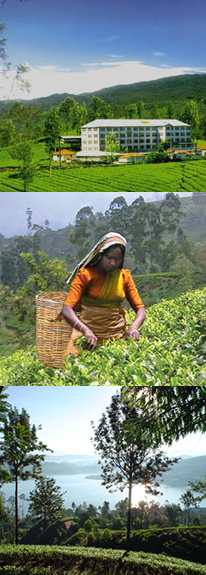 |
|
CONTACT INFO:
Ph: 09 524 2068
Ruki: 021 1313 572
Sriyan: 021 1467 499
Email:
info@teaz.co.nz
|
|
Copyright© Teaz 2006.
|
|
|
Tea Glorious
Tea...
Ceylon tea from
Sri Lanka, acclaimed as the best tea in the world has its
inherent unique characteristics and reputation running through
more than a century. The influence of climatic conditions of its
plantation imparts to the product a variety of flavours and
aromas, synonymous with quality.
Sri Lanka as
the 4th largest tea producing country globally, has a production
share of 6% in the international sphere, and one of the world's
leading exporters with a share of around 19% of the global
demand. The total extent of land under tea cultivation has been
assessed at approximately 187,309 hectares.
Sri Lanka
produces tea throughout the year and the growing areas are
mainly concentrated in the central highlands and southern inland
areas of the island. They are broadly grouped under these
headings according to their elevations:
High Grown
Tea
Ranging from
1200 metres (4,000 feet) elevation and upwards. High grown teas
from Sri Lanka are reputed for their taste and aroma and are
much sought after by blenders in tea importing countries.
Medium Grown
Tea
In areas
between 600-1200 metres (approximately 2,000-4,000 feet)
elevation. Medium grown teas produce a thick colour tea popular
in Australia, Europe, Japan and North America.
Tea Production
Enormous amount
of time, effort and passion goes to creating a great cup of
tea...
-
The Tea
plant, Camellia Sansis, takes 5 years for the seed to grow
into a tea bush that produces leaves for plucking. When the
plant is plucked two leaves and a bud are cut.
-
An
experienced plucker can pluck up to 30 kg tea leaves per
day. To make one kg black tea, approximately 4 kg tea leaves
are needed.
-
One tea
plant produces about 70 kg black tea a year, and will
produce tea for at least 50 years. A suitable climate for
cultivation has a minimum annual rainfall of 45 to 50 inches
(l, 140 to 1,270 millimetres). Tea soils must be acid; tea
cannot be grown in alkaline soils. A desirable pH value is
5.8 to 5.4 or less.
-
Tea likes
hot days, cool nights and plenty of rain, most high quality
tea is grown in mountainous regions. During the growing
season, tea is harvested every seven days.
-
Only the
two tender uppermost leaves and terminal buds are plucked by
hand. After this gentle beginning, the leaves are left in a
hot room to wither, then put into a machine that rolls the
leaves and releases their juices. These juices react with
the air (oxidation) giving black teas the colour and flavour
we love.
-
The tea is
then dried in ovens (fired) and graded according to size.
(this grading process is what is responsible for all of
those confusing letters: OP (Orange Pekoe), BP (Broken
Pekoe), and even FTGFOP (Fancy Tippy Golden Flowery Pekoe).
Generally the more initials the better the Tea.
-
The tea is
then packed and sent to Ceylon tea auctions.
-
Connoisseurs who work for brokers taste every batch of tea
and note its quality.
-
The tea is
then sold at the auctions where the market determines the
price based on supply and demand and quality.
-
'Teaz' buy
at this stage and ship it to you, fresh, pure and unblended.
...as you can see, a lot of people with passion for tea put
in many hours of work to bring you the perfect cup of tea to
be enjoyed with family and friends.
|










